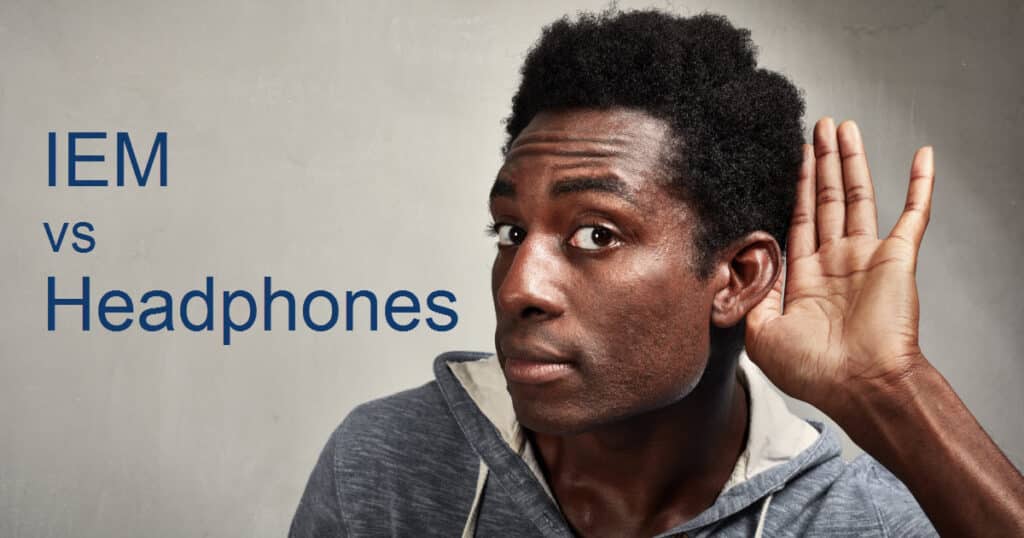In the world of audio equipment, two of the most popular options today are in-ear monitors (IEMs) and headphones. Whether you’re a musician performing on stage, a sound engineer, a studio artist, or just someone looking to enhance your music listening experience, you’ve probably compared IEM vs headphones to try to decide which one suits you better.
IEM vs headphones have features that make each of them a better option over the other for depending on the person or the circumstances. Each type of audio device also has a few drawbacks that can make them unsuitable (or inferior) in certain situations.
This article will provide an in-depth look at IEMs and headphones to help you compare, contrast, and ultimately pick which one will work better for you.
Let’s get into it!
What are IEMs?
IEMs are audio devices used by musicians to listen to and monitor the music they are playing during a performance. Some IEMs resemble the shape of an ear, while others look like two connected earbuds. Unlike traditional earbuds that sit on the ear’s opening, IEMs extend into the ear canal and create a tight seal that blocks out surrounding noise.
IEMs also have multiple drivers or transducers, which are the components that convert electrical signals into sounds. Having multiple drivers enables better management of different sound frequencies and customization of audio mixes.
There are also two options for in-ear monitors. One is the universal in-ear monitor, and the other is the custom in-ear monitor.
Universal IEMs, as the name suggests, are designed to fit anyone. They usually come with foam or rubber tips in different sizes.
Custom IEMs are specifically designed and molded to fit the wearer’s ears. Because of this, they can be more expensive than universal IEMs. You can see custom IEMs worn by singers, drummers, or any musician at a live concert.
What are the Advantages of Using IEM vs Headphones?
Using IEMS as your audio listening device provides many benefits over headphones, including the following.
- Better sound quality and on-stage performance – As mentioned above, IEMs come with multiple drivers. These provide a high-fidelity sound while reducing or completely removing noise coming from other performers on stage. If you are a singer, you can focus on the pitch of your voice better with IEMs because any other instruments being played on stage will not distract you.
- No feedback – IEMs also eliminate the need for floor wedges or monitors. They also cut down the possibility of feedback from the singer’s mic or the drummer’s condenser mics. IEMs also eliminate the task of moving large monitors and long cables on and off the stage.
- Noise isolation – IEMs are a popular choice for musicians and stage performers because of their noise-isolation feature. You can also experience this when you are commuting, studying, or working out and you want to enjoy your music with no disturbance.
- Ultimate comfort – Well-fitted IEMs will not cause any discomfort, even when worn for hours at a time. If you use your ears professionally, IEMs will prevent ear fatigue and keep your ears fresh and ready to work.
- Hearing protection – Long-term exposure to loud music or sounds can damage your eardrums. IEMs ease the strain on your eardrums because you can hear the music clearly, even at low volume.
- Freedom to move – Wearing IEMs allow you to engage in sports, running, dancing, or any vigorous activities without having to worry about losing them. They will sit tightly inside your ear with very minimal chances of falling out when you move.
- Direct control – You can listen to a wide variety of music and have personal control over what you hear. IEMs can connect to a bodypack, and from there, you can create your audio mix or adjust the volume in each ear.
What are the Disadvantages of Using IEM vs Headphones?
IEMs are a great piece of audio tool, but they also have a few weaknesses you need to be aware of.
- Detachment from the audience – Because of their noise-cancellation and noise-isolation properties, IEMs take away the sounds the audience makes. When performers don’t hear the audience cheering or singing along with their songs, they may experience a feeling of detachment or disconnection. Fortunately, performers can resolve this by putting a mic facing the audience to capture the sounds and then add them to the audio mix.
- They may fall out – If IEMs don’t fit well, they can easily fall out of your ears, especially if you’re moving around a lot. It is advisable to invest in custom-built IEMs to prevent this from happening.
- Interference issues – IEM systems use radio waves, which can pick up interference from TV or radio stations, and sometimes baby monitors. What you can do about this is to change the frequencies on the receiver and transmitter. Most brands have also resolved this issue by using dedicated signals, making interference less of a concern.
What are Headphones and How Do They Work?
By now, you may be familiar with how headphones look. They are a pair of miniature speakers mounted to a strap that clamps over your head.
Headphones have several parts, but in all models, there are three standard components. First is the magnet. It also contains the second component, called the voice coil, which is a thin piece of copper. The third component is the diaphragm, a large disc connected to the voice coil that creates vibrations and causes the voice coil to move. Every sound that plays through the headphones has an audio signal that emits an electrical current. This current pumps into the voice coil and moves inside the magnet.
Over-the-ear headphones come in two types: closed-back headphones, and open-back headphones.
Closed-back headphones are sealed around the back, which make them excel at isolating noise. They are ideal for casual listening or when recording audio.
Open-back headphones allow air to pass through the ear cups to minimize pressure buildup and echo inside the headphones. However, they cannot block outside noise well. This means that open-back headphones are more suitable for at-home listening or listening to high-quality audio and not for commuting or public spaces.
What are the Advantages of Using Headphones?
Headphones are commonly used by DJs, gamers, and audiophiles. Here’s why.
- Ease of use – Like earbuds and IEMs, the best attribute of headphones is that you can control them with ease. Most styles have built-in volume controls and forward and backward buttons. You can also pick up calls easily when your headphone is connected to your phone.
- Design – Sometimes, headphones are used in making a fashion statement or as a means of self-expression. They come in a variety of styles and colors that can match your mood, personality, or even your outfit.
- Connectivity – You can connect your headphones with almost any device through its 3.5mm jack or connector. Not only can you use it on your smartphone, but you can also use it on a computer, gaming console, or music system.
- Noise Cancellation – Similar to IEMs, headphones create a vacuum-like environment over the ears, reducing ambient sounds down to zero.
- Sound quality – Headphones have larger drivers that deliver superior sound quality over their smaller counterparts, the earbuds.
- Comfort – For people who don’t want to jam earbuds or IEMs into their ear canals, headphones are a comfortable alternative, with ear cups that sit around the ears. Since headphones are worn over the head, they don’t fall easily, unlike earbuds and IEMs.
- Distance – Wired headphones usually have cords that are one to two meters, while wireless or Bluetooth headphones can work from a distance of up to nine meters. This allows you to keep your headphones connected to any device from a distance while you’re doing a task or lounging on your bed.
What are the Disadvantages of Using Headphones?
Headphones have many notable advantages, but just like any other device, they also have a few drawbacks.
- Prone to damage – Some parts of a headphone are vulnerable to wear-and-tear or neglect. For example, stretching or tugging at the plug or the wire can break them. Exposing your headphones to extreme heat and moisture and not cleaning them regularly may also cause damage.
- Cost – If you want to use high-quality headphones, you may need to purchase a high-end model or a well-known brand. You may have to be meticulous when buying headphones offered at low price points because they may not deliver in terms of sound quality.
- Limited mobility -Over-the-head headphones and wired headphones limit movement, which make them unsuitable for activities such as working out, yoga, and sports.
- Health effects -Remember, excessive use of anything can pose health risks. Prolonged use of headphones, especially at a high volume, may lead to hearing loss. Or worse, they can affect brain function.
Both IEMs and headphones are designed to let you enjoy your favorite music, games, movies, podcasts, or TV shows. Now that we have discussed how they work and the pros and cons of using IEM vs headphones, we hope that we are able to help you decide which one will suit your needs the most.




